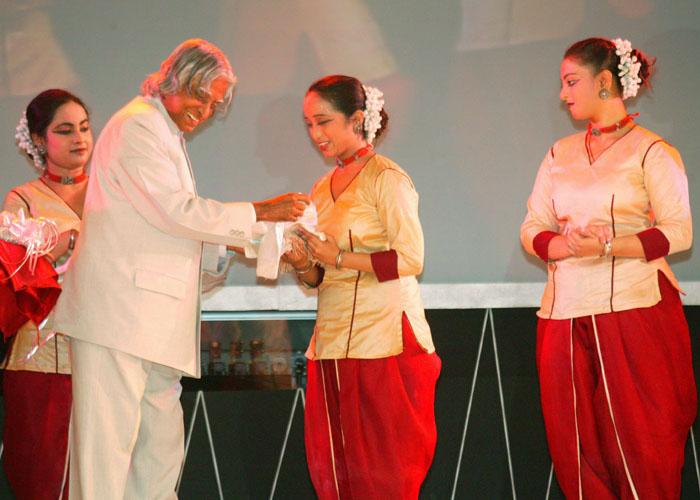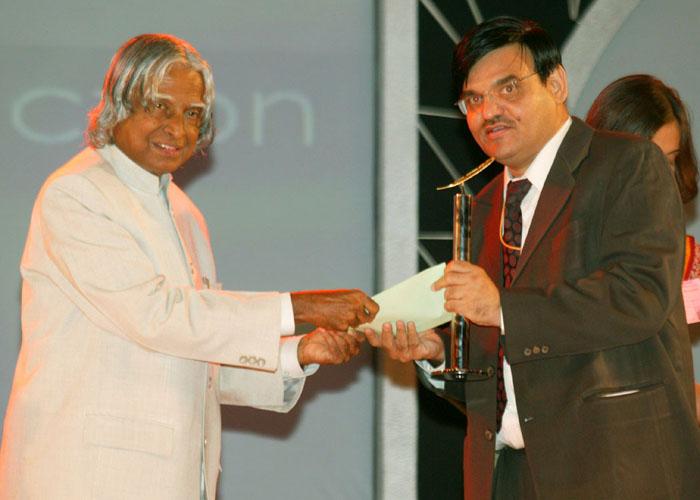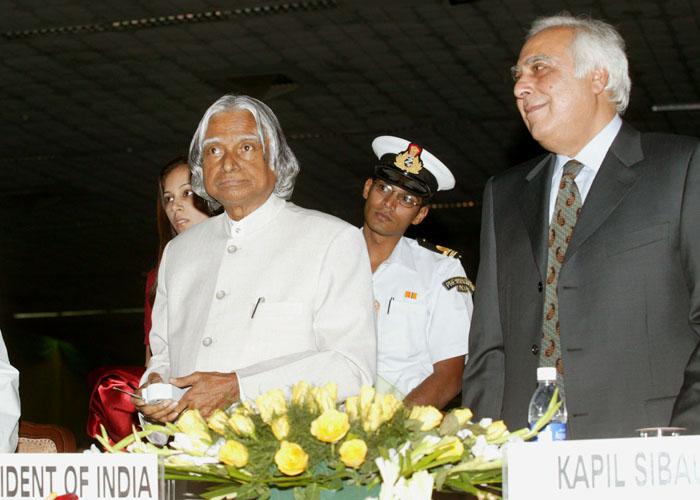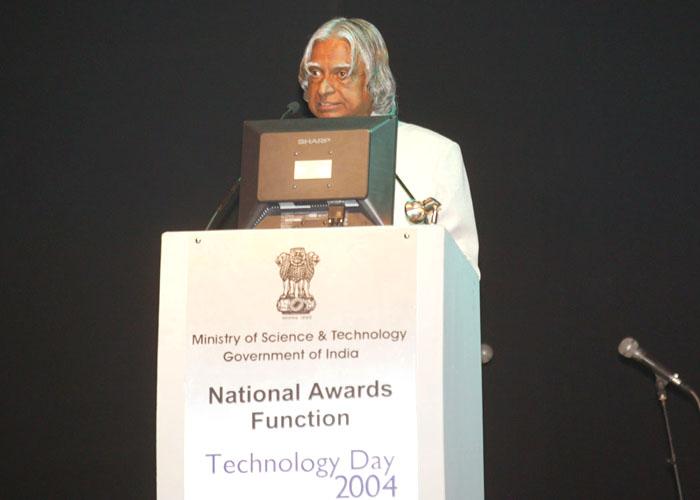Address At The Technology Day Award Function, Pragati Maidan, New Delhi
New Delhi : 30-06-2004
Technology for Societal Transformation
I am indeed delighted to participate in the Technology day awards function 2004 organized by Ministry of Science and Technology. My greetings to all the award winners, Organizers, members of the Technology Development Board of Department of Science and Technology, distinguished guests and other teams.
Technology Day
During my periodical address over AIR, on Technology Day - 11 May 2004, I narrated the milestones and the progress India has achieved technologically in the year 2003-2004. It may be relevant to you. We had received hundreds of inputs from our technological community across the nation in various disciplines. For brevity, I had discussed nine technological events, which had the potential to penetrate into our economy and assist the transformation of our society. They were: Seed Cotton Productivity; Electricity Generation from Municipal Waste; A Brand in Automobile Technology; Fast Breeder Reactor; Birth of an Indian Cryogenic Engine; Light Combat Aircraft (LCA) - TEJAS crossing the Sonic Barrier; Mapping the Neighborhood by the Children; Synergy Mission for Environmental Upgradation and Digital Library in every Panchayat. You may get the details from my website .
Today I would like to focus on the technological challenges, which will enable faster transformation of India into a developed nation. What should be our essential need? How to channellize our energies? How to make use of our core competence, the human resource and physical resource to the national advantage?
Integrating Space, Information, Nano and Bio-technology for Societal transformation
The national developmental challenges are many involving integrated action namely: Agriculture and Food Processing, Education and Health care, Information and Communication Technology, Infrastructure and self-reliance in critical technologies. As technologists, you can contribute in many areas like education, healthcare, disaster prevention & mitigation, e-governance, urban planning, rural communication, PURA (Providing Urban Amenities in Rural Areas) and importantly Interlinking of Rivers. It depends on the integrated application of one technology with other or in combination of multiple technologies such as Biotechnology, Information Technology, Space Technology, and Nano-technology for innovative missions that must address pro-actively acute problems of rapid depletion of conventional energy sources, drinking water supplies, and deliver solutions for the man-planet conflict that has led to pollution, climatic change and degradation of ecology and the environment. Hence I am going to discuss with you about the connectivities, which are important in bringing prosperity to rural India, the foundation of our society.
Rural Prosperity through Connectivity (RUPCON)
As you are aware, nearly 700 million people of India live in the rural areas in 600,000 villages. Connectivity of village complexes providing economic opportunities to all segments of people is an urgent need to bridge the rural-urban divide, generate employment and enhance rural prosperity.
Essential Connectivities
The integrated methods, which will bring prosperity to rural India are: the physical connectivity of the village clusters through quality roads and transport; electronic connectivity through tele-communication with high bandwidth fiber optic cables reaching the rural areas from urban cities and through internet kiosks; knowledge connectivity through education, vocational training for farmers, artisans and craftsmen and entrepreneurship programmes; and economic connectivity through starting of grassroots level innovation driven enterprises and self-help groups with the partnership of banks, micro credits for marketing the cost effective products for improving productivity and mass consumption.
Economic growth with Employment generation
To prevent migration of workforce from rural to urban areas, enriching the rural life, an employment generation in rural areas is essential. Teaching entrepreneurship in educational institutions and providing necessary opportunities for sustainable self-employment backed with investment, technology will be an employment generator. The integrated chain of connectivities (Physical, Electronic, Knowledge resulting into Economic) in a time bound manner along with venture capital funding will generate economic development with large scale employment potential leading to rural prosperity. I would like to discuss two examples - tele-education and seawater desalination, where technology infusion is needed.
Tele-education
When we provide electronic connectivity to the rural areas with the broadband, satellite and wireless connectivities for last mile access, it paves the way for knowledge enablement to the rural people via tele-education. Through this, we can take the knowledge to their doorsteps with the latest innovations, digital library, experiences in value-addition, state-of-the-art practices, system oriented approach, entrepreneurial management skills, technical skills, business knowledge with the help of Universities, R&D organizations, Industries, Management and Technical institutions. It also provides a backbone for the schools where adequate number of quality teachers is not available. Tele-Education will enable the teachings of the good teacher available to the remote corners of the nation in a two-way tele-education mode. A good teacher from remote rural area also can teach seamlessly from the remote location to the other parts of the country. The present systems available do not provide these facilities in full and are expensive. The infusion of technology is needed to make these systems affordable for every one of our panchayat and our villages, so that the knowledge can reach the common man in all the corners of the nation. We are advancing in this direction. I would like to give my recent personal experiences. Rashtrapati Bhavan was connected to Carnegie Mellon University, Pittsburgh, USA through Internet and voice over IP (Internet Protocol) in a low bandwidth configuration. I had an interactive conference with the scientists of CMU on ?Digital library for every panchayat in India?. Also, during this week, I interacted with the scientists from NASA and India attending the Indo-US space congress, at Bangalore from Rashtrapati Bhavan using VSAT. Both these technologies? the satellite based and Internet based, are complementary to each other and are needed for tele-education. Satellite communication provides one to many connections with easy scalability to even a billion people. The Internet based technology is a connection less network and because of its use of IP; it is amenable to even for communicating with small form factor mobile devices. These are good for one to few interactive interactions. When we talk about remote education, we need to have a combination of intense interaction between the students and the teachers but when it comes to delivery of lectures, technologies for communication of one to many should be made cost effective and affordable. We should also create quality content so that our entire education can be remotely accessible and can work seamlessly with our collegiate and school education. These systems with certain additional medical instrumentation should provide tele-medicine and even health awareness facility also. Tele-medicine connects Urban hospitals, District hospitals to the Primary Health Centers in the rural areas.
Seawater desalination solution: technology and process
Globally, there are a few solutions to solve water shortage. I would like to give certain suggestions; definitely it may be of interest to you. The first solution is by redistribution of water. India has already started this by wide spread promotion of rain water harvesting in both rural and urban areas, but it has to be done in a mission mode as few states are already doing. In addition we need to put a stop to large-scale wastage of water and promote water recycling on compulsory basis in urban and rural areas. It is essential to note that we get monsoon rain only for three months in most of the places, whereas the consumption is for all 365 days using the ground water. The other major programme, which is under the consideration of the Government, is the linking of rivers, which also need multiple technological inputs.
Desalination methods
Fortunately, we have a resource of 91% of water in the form of oceans and seas. Therefore, second solution would be to create new perennial sources of fresh water by seawater desalination. There are many desalination plants already established all over the world. Every year in our country, the drought or flood conditions are experienced damaging the habitat and certain human loss. We resort to partial solutions with large amount of expenditure. Presently in India there is certain water management for irrigation purposes useful for food production. The demand for food may get doubled in two decades. Therefore the planning of water through desalination process and interlinking of rivers has to be planned together in the development of additional water resources for irrigation and potable water for drinking.
Development of desalination technology
India attaches importance to technological solutions for various desalination processes. Fortunately Department of Atomic Energy, DRDO, CSIR, IIT Madras and academic institutions are working in different processes for desalination, whereas we should recognize that there are already operational plants elsewhere in the world. Nuclear Desalination Demonstration Project (NDDP) at Kalpakkam has demonstrated the safe and economic production of good quality water by desalination of seawater comprising of 4500 cubic meter per day by Multi Stage Flash (MSF) and 1800 cubic meter per day by Reverse Osmosis (RO) plant. The plants can be scaled up many times. The design of the hybrid MSF-RO plant to be set up at an existing nuclear power station is another solution. The MSF plant based on long tube design requires lesser energy. The effect on performance of MSF plant due to higher seawater intake temperature is marginal. The preheat RO system part of the hybrid plant uses reject cooling seawater from MSF plant. This allows lower pressure operation, resulting in energy saving. The two qualities of water produced are usable for the power station as well as for drinking purposes with appropriate blending. The post treatment is also simplified due to blending of the products from MSF and RO plants. Another approach is the use of dual-purpose plants, where the desalination plant is connected to an electricity plant, utilizing the waste heat from the electricity plants run by nuclear energy. I understand, under favourable conditions, dual-purpose plants decrease the cost of desalinated water below those of conventional desalination methods, primarily through energy conservation.
Desalination process
Last year, I visited the Umm Al Nar desalination plant in Abu Dhabi, which produces nearly 500 million litres of fresh water per day using the MSF (Multi Stage Flash) process. This one plant has totally transformed the ecology of the desert, and is an example of how large scale water supplies may be obtained from the oceans. In this process the seawater has to be flashed into steam by heat addition at low pressure. When the steam is condensed to produce fresh water, part of the energy is used to run steam turbines to produce electricity to feed back to the grid.
But for India we need new processes and new solutions like use of reverse osmosis using solar energy and MSF using nuclear energy. It is also essential to set up the desalination plants next to the nuclear power stations to reuse the waste energy effectively. The technologists and industrialists who have assembled here should come out with unique technological solution to produce water for drinking and irrigation through seawater desalination process in a cost effective manner.
Now I would like to discuss how innovation could be nurtured through the infusion of technology and the need for instituting of a special award by Technology Development Board.
Innovation: key to economic strength
In the Ministry of Science and Technology there are two major schemes, which I am personally aware of. Technology Development Board, which leads to commercialization of technologies, developed by lab/industry and also we are witnessing today technology awards is given to recognize the excellence. The same Ministry has another important scheme through National Innovation Foundation tasked with the mission of bringing out and growing national grass root technological innovations and traditional knowledge. They give awards to a few grass root innovations, which are selected, from thousands of proposals. Some of the innovations for which awards have been given in the past years are: Low cost hand pump, Coconut harvester, Portable power generating device, Convertible three wheel tractor, Self propelled weeder etc., But very rarely, these innovations are converted into a commercial proposition having a societal impact. The Technology Development Board may consider introducing from the year 2005, at least two awards exclusively for shaping the innovation into a globally competitive commercial application through technological value addition with appropriate funding mechanism. This may need nurturing of two thousand innovations to select two. Now I would like to discuss with you the law of development, which brings out the need for competitiveness in our products.
Law of development
How to become competitive? I was studying the development patterns and the dynamics of connectivity between nations, especially in trade and business. As you all know, the world has a few developed countries and many developing countries. What is the dynamics between them and what connects them? Developed country has to market their products in a competitive way to different countries to remain as developed country. The developing country to get transformed into developed country; they too have to market their products in other countries in a competitive way. Competitiveness has three dimensions: quality of the product, cost effectiveness and supply in time. Indeed this dynamics of competitiveness in marketing of products by developing and developed countries determines the law of development. We have to see our integrated missions for national development with competitiveness index in mind.
Conclusion
Friends, I have worked in many technological areas and management groups and based on certain experiences, I have evolved a definition for technology:
Technology as integration of a multiple proven scientific results and put to use for national development and thereby prosperity.
Technology can also be defined as maturity of scientific discovery to result in multiple applications.
Of course there is a time difference between innovation and commercialization. In electronics and communication systems it takes less than five years for invention to become an application/product and about ten years for material and manufacturing fields.
Technology is a nonlinear tool that can effect the most fundamental changes in the ground rules of economic competitiveness
Science is linked to technology through applications
Technology is linked to economy and environment through manufacture
Economy and environment link Technology to society
The integrated relationship of science, technology, and environment, manufacturing and marketing has tremendous impact on the society. I congratulate all the awardees and greet the organizers from DST.
Wish you success in your mission of promoting technology for societal change. May God Bless You.




